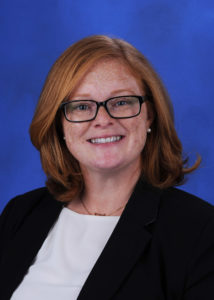If you’d told Aurore (Rorie) Zuzick ’09 10 years ago that she would eventually represent the U.S. Navy on NATO’s Ship Design Capability Group Specialist Team, she wouldn’t have believed you.
“Who thinks that?” she laughed while reflecting on it. “I just wanted to make a small boat that you could easily repair, and I ended up here. My father was in the Air Force, my grandfathers were in the Navy, so the family was pro-DOD, but I hadn’t realized that I would go into the Navy world myself. But I’m very pleased I have.”
That’s the kind of opportunity that has become routine for Zuzick, who works as a naval architect in Carderock’s Full-Scale Trials Branch at Naval Surface Warfare Center, Carderock Division in West Bethesda, Maryland. She never predicted the smaller boats that were a daily part of her life growing up would lead to her conducting performance trials on the Navy’s massive, powerful ships.
“I grew up on Cape Cod, so we always did boating,” Zuzick said. “Sailing mostly, but rowing, too. Anything that floated, we were on it: put on a jacket and go play. It’s a total New England thing.”
Zuzick said she spent several summers working for a small boat dealership growing up, which involved rigging, fixing, assembling and repairing boats. This was the first time she became interested in learning about boat building, but her life wouldn’t head in that direction immediately. She spent her high-school years competitively snowboarding, which she returned to after she found a stint attending Massachusetts Institute of Technology not to her liking at the time and decided to try something else. At first, that meant moving out West and being a ski bum for three years before realizing she needed to return to what she loved. This meant becoming a “Webbie” by attending Webb Institute, a tiny school on Long Island, New York, that graduates 15 to 20 students a year in just one degree plan: naval architecture and marine engineering.
“There are a ton of Webbies in the Navy,” Zuzick said. “It’s a really small pool, but relative to Webb’s size, a lot of them end up working for the Navy, maybe half. In the small world of naval architecture, people get really excited when they meet another Webbie.”
At Webb, Zuzick found working on computational fluid dynamics (CFD) the most interesting and decided to pursue that her senior year.
“Water is very complicated. It’s a very challenging problem to solve. CFD is really a field that was enabled by big computers. It’s been growing, and it’s gotten more interesting, particularly back then [in the late 2000s],” Zuzick said. “I met another Webb alum and he told me, ‘If you want to do your senior year internship at Carderock, we can make that happen.’ I knew what Carderock was, but what initially drew my interest was CFD. The nerdy subject matter kind of got me in the door, and then when I learned about the quality of these facilities and the mission of the command, I was hooked.”
Zuzick’s main duties involve testing the ability of ships to perform certain activities safely in certain weather conditions. She usually works at West Bethesda and the Washington Navy Yard, but she also travels, sometimes to underway surface ships. She said doing that has definitely given new meaning to terms like “reliability metric.”
“You have to deal with what you have out there – it’s not about a PowerPoint slide. Your crew is not sleeping when they’re fixing something that’s broken. So you get a good reminder to have perspective on things like that when you have an opportunity to be at sea for a good little while,” Zuzick said. “We go out for one to three weeks and we’re out there working like crazy. You get to meet everybody, you get to ask questions and you get to learn about how your work affects the people in the fleet. That’s an important relationship you don’t get when you’re in the office all the time.
“These ships have to float, they have to go at the speed you want with the power you’ve given them, getting as far as they need to with the fuel they have, and so on, sometimes in really bad waves,” Zuzick continued. “It’s kind of a nutty jigsaw puzzle, but it’s interesting when you’ve got bugs to work out. You learn a lot from the process, and it’s really fun.”
Since coming aboard Carderock in 2009, Zuzick earned her master’s degree in mechanical engineering from the University of Maryland. She spent time last year as a member of the Leadership Education and Development (LEAD) Program, an unexpected opportunity she said she was grateful to Carderock Technical Director Dr. Tim Arcano for selecting her for the program. The LEAD Program was developed to provide high-performing, journey-level professionals at Carderock with the strategies and tools to lead across the division. Through the program, participants develop and strengthen their leadership skills and obtain a broader outlook of Carderock and Naval Sea Systems Command (NAVSEA) by participating in activities that range from book discussions to rotational assignments.
Zuzick said another perspective moment for her was bringing her family to October’s commissioning of the Navy’s newest and most technologically advanced warship, USS Zumwault (DDG 1000), in Baltimore. She said that she doesn’t often get a chance to step back and think about what she’s been a part of in this job, but seeing their reaction made that happen for her.
“They were over the moon; they were so impressed and it reminded me in turn that it really is very impressive and important,” Zuzick said. “Of course, a lot of other people did a heck of a lot more work with that ship than I have, but I’ve been working on it for pretty much the whole time I’ve been with the Navy, and it’s exciting just to say you’re doing something that benefits other people.”
Zuzick said when she isn’t working, she’s usually sailing with her husband, Travis, a boat builder in Annapolis whom she wed in September. But whether it’s with small boats in her spare time or surface ships at work, it’s a sure thing this Webbie will be working and playing on the water for a long time to come.
Naval Surface Warfare Center, Carderock Division, a part of Naval Sea Systems Command, leads the Navy in hull, mechanical and electrical engineering. Headquartered in West Bethesda, Carderock Division employs approximately 2,000 scientists, engineers, technicians and support personnel and includes detachments in Norfolk (Little Creek); Port Canaveral, Florida; Fort Lauderdale, Florida; Memphis, Tennessee; Bangor, Washington; Ketchikan, Alaska; and Bayview, Idaho.
Story provided by Dustin Q. Diaz, Naval Surface Warfare Center, Carderock Division Public Affairs


